Guide to Leadership in Manufacturing: Strategies for 2025
The manufacturing sector is entering a period of rapid transformation, where traditional approaches no longer guarantee success. To thrive in this changing landscape, organizations must embrace new models of leadership in manufacturing that prioritize adaptability, innovation, and resilience.
This guide delivers practical strategies, proven frameworks, and real-world examples to help leaders, managers, and HR professionals navigate the future. You will discover essential leadership qualities, strategic approaches, technology integration, talent development, change management, and future trends.
Unlock higher productivity, boost employee engagement, and drive sustainable growth. Start building a high-performing team for 2025 and beyond by adopting these actionable insights today.
The Evolving Role of Leadership in Manufacturing
Manufacturing is experiencing a seismic shift in how organizations define and practice leadership in manufacturing. With the rise of digital transformation, changing workforce dynamics, and global competition, leaders must adapt rapidly to remain effective.
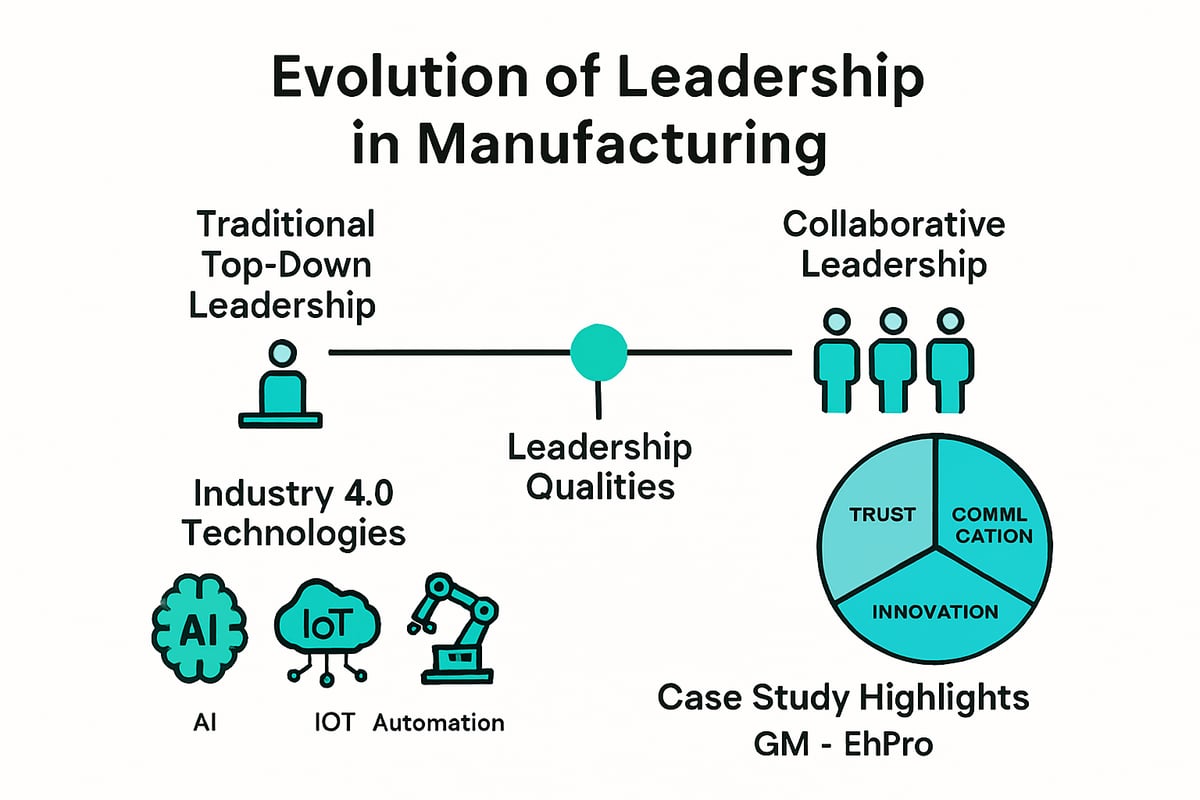
From Traditional to Transformational Leadership
For decades, leadership in manufacturing relied on strict hierarchies and top-down decision-making. Early icons like Henry Ford set the tone, emphasizing efficiency and control over collaboration.
Today, the industry looks very different. Transformational leaders are replacing autocratic models with approaches that prioritize empowerment, open communication, and shared vision. This evolution is largely driven by the demands of Industry 4.0, where technology and data are central to every operation.
Manufacturing leaders now face new complexities, such as managing global supply chains, adapting to rapid market changes, and leading highly diverse teams. Success requires aligning leadership strategies with both organizational vision and ever-shifting market demands. The days of one-size-fits-all leadership in manufacturing are over.
Core Leadership Qualities for 2025
What will set successful leaders apart in 2025? Building trust is essential, achieved through transparency, regular communication, and authentic engagement with teams. Leaders must inspire passion and purpose, helping staff see the excitement and impact behind their work.
An entrepreneurial mindset is also critical. This means encouraging innovation, calculated risk-taking, and a relentless focus on customer needs. Leaders must act as agents of change, driving transformation and championing continuous improvement at every level.
Consider this: companies with high-trust cultures outperform their peers by up to 286% in total return to shareholders, according to IndustryWeek. Clearly, investing in the right leadership in manufacturing qualities will pay dividends for years to come.
Example: GM’s Mary Barra & EnPro’s Development Programs
Mary Barra, CEO of GM, exemplifies visionary leadership in manufacturing. Her push for electrification and willingness to make difficult decisions, like plant closures, demonstrate a commitment to long-term success over short-term comfort. Barra’s strategy inspires trust, even in challenging times.
EnPro takes a different but equally powerful approach by investing heavily in leadership development. Their personal growth mapping ensures every employee has a clear path to progress, fostering both individual and organizational growth.
For more real-world insights, explore these manufacturing industry leadership case studies to see how leaders are driving change across the sector. These examples show how bold vision and a commitment to talent development can transform manufacturing organizations.
Key Strategies for Effective Manufacturing Leadership
To excel at leadership in manufacturing, leaders must evolve their approach as technology, workforce expectations, and market demands shift. The most effective strategies blend visionary thinking with practical actions, enabling manufacturing teams to innovate, adapt, and deliver results. Below, we break down the core strategies every manufacturing leader should master to thrive in 2025.
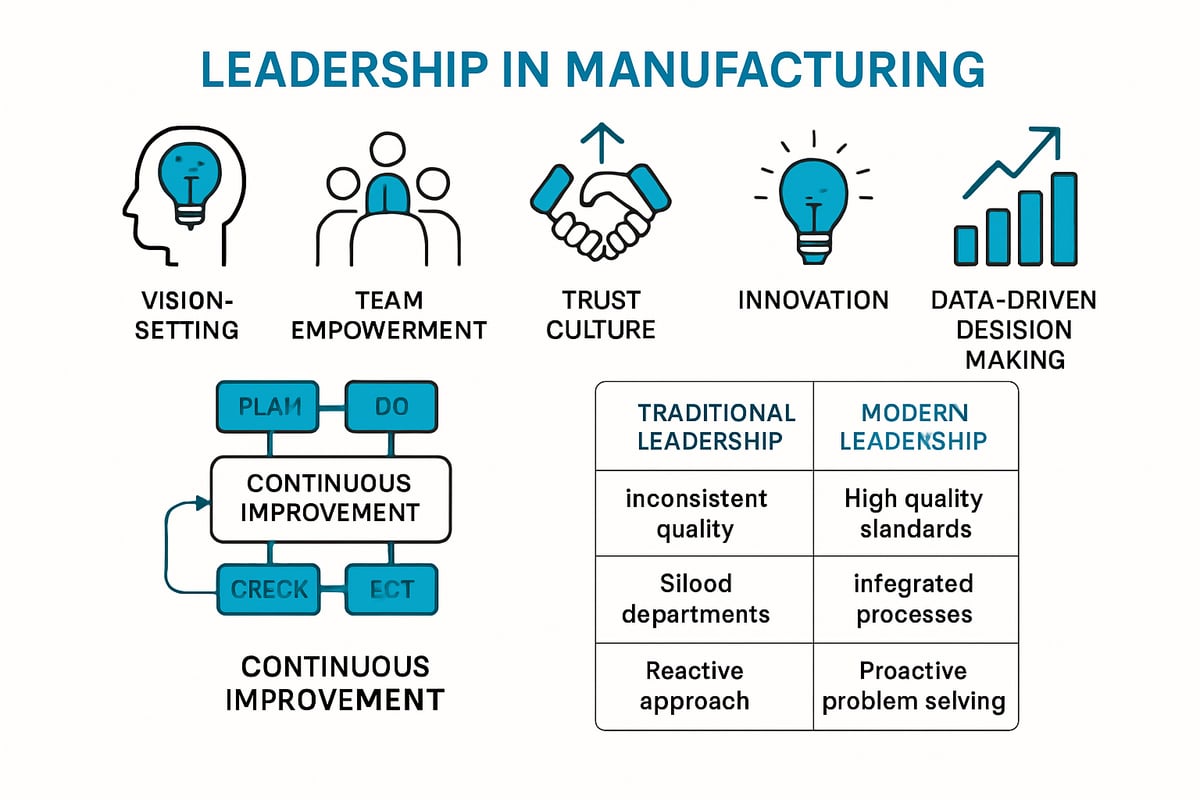
Establishing a Clear and Inspiring Vision
A compelling vision is the foundation of effective leadership in manufacturing. Leaders must articulate where the organization is headed, why it matters, and how every team member contributes. This vision should be more than a slogan—it needs to be woven into daily actions, decisions, and communication.
Storytelling helps embed the vision into the company culture. Leaders who highlight real-world examples, such as Magna’s holistic approach to integrating new technology, inspire teams to rally around a shared purpose. Consistent reinforcement through meetings and visible actions ensures alignment and keeps everyone motivated.
A clear vision makes it easier to navigate change and prioritize initiatives. It also serves as a north star for decision-making, ensuring that even during disruption, the team stays focused on long-term goals. Leadership in manufacturing relies on this unifying direction to drive sustainable growth.
Empowering Teams and Fostering Accountability
Leadership in manufacturing is shifting from micromanagement to trust and empowerment. Modern leaders provide autonomy, encouraging employees to take ownership of their work and decisions. This approach boosts morale and accelerates problem-solving on the shop floor.
Empowering teams starts with providing the right tools, training, and resources. When employees feel equipped and trusted, they are more likely to innovate and meet ambitious targets. For example, Rohr’s focus on respect and empowerment led to outperformance compared to traditional plants within just six months.
Accountability is the natural partner of empowerment. Leaders set clear expectations, give regular feedback, and recognize achievements. This balance creates a culture where team members feel responsible for outcomes and motivated to excel.
Building a Culture of Trust and Continuous Improvement
Trust is the engine that drives high-performing teams. Leadership in manufacturing flourishes when leaders are transparent, communicate openly, and engage authentically with employees. Trust fuels collaboration, creativity, and resilience in the face of change.
Intentional culture design is key. Leaders should encourage regular feedback, celebrate contributions, and foster a sense of belonging. At Kaman, ongoing learning and tuition reimbursement help employees grow and stay engaged, supporting both retention and performance.
Continuous improvement is more than a buzzword—it’s a mindset. Leaders cultivate this by supporting experimentation, learning from mistakes, and sharing best practices across the organization. The result is a workplace where progress is constant and everyone feels invested in success.
Driving Innovation and Entrepreneurial Thinking
The future of leadership in manufacturing depends on a leader’s ability to spark innovation at every level. Leaders must create an environment where new ideas are welcomed, tested, and implemented. This means giving teams permission to take calculated risks and rewarding creative problem-solving.
Initiatives like Miller Ingenuity’s “Creation Station” show the power of dedicated spaces for collaboration and idea generation. Leaders should encourage cross-pollination of skills and perspectives, which can lead to breakthrough solutions.
Balancing operational efficiency with innovation is crucial. Leaders must manage resources wisely while still carving out time and budget for experimentation. Entrepreneurial thinking keeps organizations agile and ready to seize emerging opportunities.
Cross-Functional Collaboration and Agile Leadership
Silos are the enemy of progress in leadership in manufacturing. Leaders must actively break down barriers between departments such as operations, R&D, marketing, and finance. Cross-functional teams bring diverse skills together to solve complex challenges faster.
Using agile methodologies, like short-cycle deliverables and regular check-ins, helps teams adapt quickly to changes. For instance, leveraging 3D printing has enabled teams to prototype and enter new markets with speed and flexibility.
Agile leadership requires adaptability and a willingness to pivot. Leaders should model openness to change and empower teams to make decisions quickly, ensuring the organization stays ahead in a dynamic industry landscape.
Data-Driven Decision Making and Technology Adoption
Modern leadership in manufacturing is grounded in data. Real-time insights from OEE software, digital twins, and IoT devices enable leaders to make informed, timely decisions that boost productivity and competitiveness.
Adopting advanced technologies—AI, automation, robotics—requires digital fluency. Leaders must champion technology adoption, guiding teams through transitions and ensuring everyone is upskilled for new tools.
Integrating people, processes, and tech is essential for success. For a deeper dive into how this integration shapes leadership in manufacturing, see People, Processes, Tech: How Manufacturing Leaders Can Succeed In 2025.
Leaders who embrace data-driven strategies not only optimize operations but also foster a culture of continuous improvement and innovation.
Developing and Retaining Top Manufacturing Talent
Attracting, developing, and retaining talent is at the heart of effective leadership in manufacturing. Today's industry faces a generational shift, new skill demands, and increasing competition for top performers. Building a strong, future-ready workforce requires a multi-pronged approach.
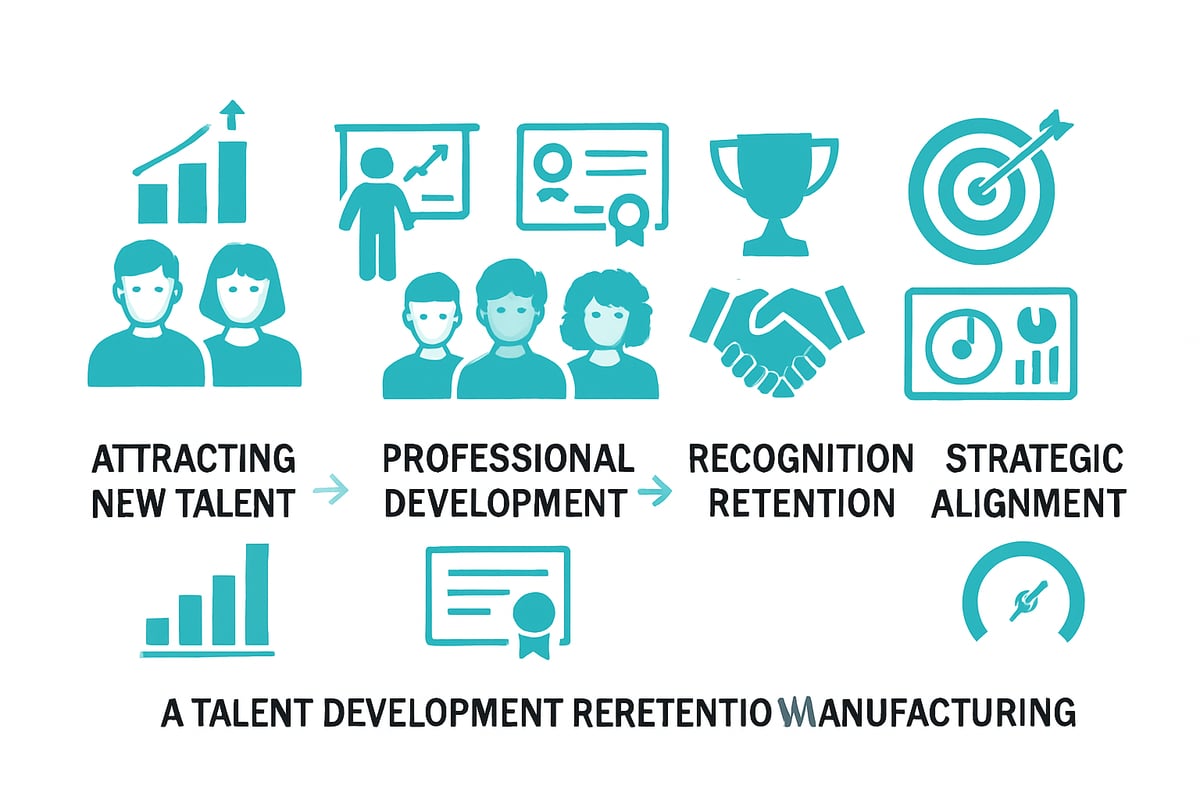
Attracting the Next Generation Workforce
The future of leadership in manufacturing depends on appealing to younger generations. Millennials and Gen Z seek purpose-driven work, flexibility, and opportunities to make an impact. To close the ongoing skills gap, organizations must rebrand manufacturing as a tech-forward, innovative field.
Companies are highlighting digital transformation, sustainability, and advanced automation to attract talent. Offering meaningful projects, flexible schedules, and clear career paths signals that manufacturing is a dynamic, rewarding environment. By showcasing real employee stories and growth trajectories, leaders can inspire new talent and reinforce the value of leadership in manufacturing.
Investing in Professional Development & Upskilling
Continuous learning is a cornerstone of leadership in manufacturing. Tuition reimbursement, structured skills training, and robust leadership development programs ensure employees are equipped for evolving industry needs. Mentorship and coaching, especially when initiated early, help identify and nurture future leaders.
Organizations that encourage knowledge sharing and employee-led improvement initiatives see stronger engagement and innovation. To further support this, developing high-performing manufacturing teams with specialized leadership programs can drive both individual and team growth. These investments create a culture of advancement and make leadership in manufacturing a compelling career choice.
Fostering Diversity, Equity, and Inclusion (DEI)
Diversity and inclusion are critical drivers for leadership in manufacturing. Building diverse pipelines ensures organizations reflect global markets and bring a variety of perspectives to problem-solving. Implementing DEI best practices in recruitment, promotions, and daily interactions fosters a sense of belonging.
Data consistently shows that diverse teams are more innovative and financially successful. For example, McKinsey reports that diverse teams are 35% more likely to outperform their peers. Embedding DEI into leadership in manufacturing not only supports ethical standards but also unlocks business growth.
Recognition, Engagement, and Retention Strategies
Retaining top talent hinges on strong recognition and engagement systems. Leaders who foster transparent communication, regular feedback, and appreciation create cultures where employees feel valued. Linking engagement to productivity and retention rates allows organizations to measure impact.
Inditex’s flat structure and informal leadership style exemplify how a positive environment keeps people motivated. Recognition programs, team celebrations, and visible career advancement opportunities help reinforce the importance of leadership in manufacturing and reduce turnover.
Aligning Leadership Development with Business Goals
For leadership in manufacturing to truly drive results, development efforts must align with organizational strategy. Setting measurable KPIs for leadership growth ensures progress is tracked and goals are met. Integrating leadership development with business planning and compliance standards strengthens both individual and company performance.
By making leadership training a strategic priority, manufacturers can build a resilient, adaptable workforce ready to tackle tomorrow’s challenges. This approach turns leadership in manufacturing into a sustainable competitive advantage.
Leading Change and Managing Transformation in Manufacturing
Change is no longer a one-time event in manufacturing. Instead, it's a continuous process that demands adaptable leaders who can guide teams through uncertainty. Leadership in manufacturing has evolved, and today's leaders must champion transformation to keep organizations competitive.
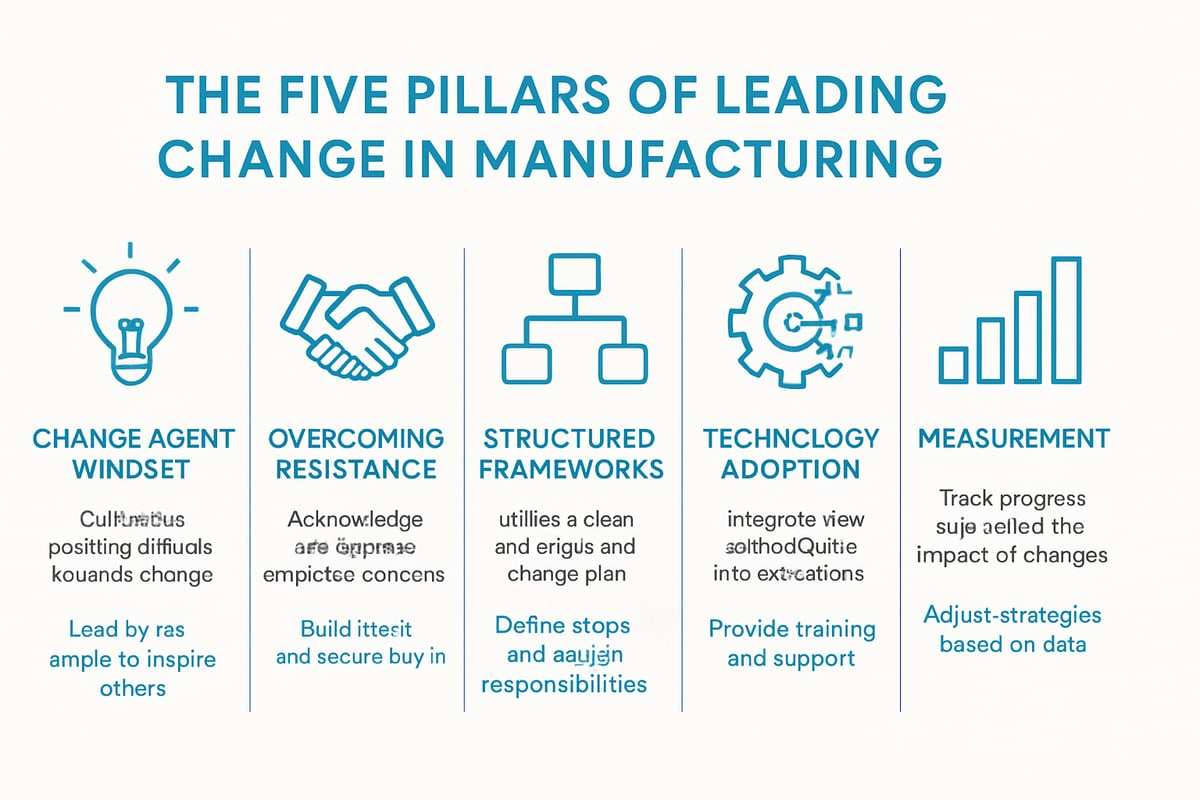
Becoming a Change Agent: Mindset and Methods
Effective leadership in manufacturing starts with a change-ready mindset. Leaders must see themselves as catalysts for transformation, not just guardians of routine. Visionary leaders inspire teams by communicating a compelling case for change and demonstrating resilience.
For example, GM’s pivot to electrification under Mary Barra showcased how bold vision and decisive action can shift organizational direction. To succeed, leaders should:
- Embrace continuous learning
- Model adaptability and openness
- Foster a culture of experimentation
By making change a part of daily operations, leadership in manufacturing becomes a driving force for sustained innovation and growth.
Overcoming Resistance and Building Buy-In
Change often sparks anxiety, especially on the factory floor. Leaders who succeed at transformation address concerns with empathy and transparency. Open forums, regular updates, and involving frontline employees in decision-making can create grassroots support.
Coaching also plays a crucial role. Solutions like leadership coaching for manufacturers empower managers to build trust and develop communication skills that ease transitions. When employees feel heard and valued, resistance drops, and engagement rises.
Ultimately, leadership in manufacturing means guiding teams through uncertainty, turning skepticism into shared commitment.
Strategic Change Management Frameworks
Structured frameworks help leaders manage transformation systematically. Models like Kotter’s 8-Step Process or ADKAR provide clear steps, from building urgency to anchoring new behaviors. These frameworks ensure everyone knows their role and progress is measurable.
Here's a simple comparison:
| Framework | Focus | Key Steps |
|---|---|---|
| Kotter | Organizational change | 8 steps, vision, wins |
| ADKAR | Individual change | Awareness, desire, etc. |
For more on risk management and streamlined processes, see Manufacturing Leadership Strategies for Streamlined Processes. Using proven frameworks, leadership in manufacturing becomes more predictable and resilient.
Leveraging Technology for Transformation
Digital tools are at the heart of modern transformation. Leaders must be champions of technology adoption, guiding teams through the integration of machine monitoring, production scoreboards, and digital twins.
Real-time data and analytics improve decision-making speed, making operations more efficient. When leadership in manufacturing embraces technology, they unlock new efficiencies and keep pace with industry advances.
To ensure success, provide digital training and encourage experimentation. This approach not only boosts productivity but also builds confidence and adaptability within teams.
Measuring and Sustaining Change
Sustaining transformation requires constant measurement. Setting relevant KPIs and tracking progress ensures that changes deliver real results. Celebrate quick wins to maintain momentum and reinforce positive behaviors.
Feedback systems, such as regular check-ins and anonymous surveys, help leaders adapt strategies and address issues early. Leadership in manufacturing thrives when leaders create a culture of accountability and continuous improvement.
By embedding measurement into daily routines, organizations can sustain transformation and remain agile in the face of future challenges.
Future Trends and Emerging Challenges for Manufacturing Leaders
The future of leadership in manufacturing is being shaped by rapid technological change, global pressures, and shifting workforce dynamics. Leaders must adapt quickly to stay ahead, leveraging new skills and strategies to guide their organizations through uncertainty.
Navigating the Digital Revolution and Industry 4.0
AI, robotics, and IoT are revolutionizing leadership in manufacturing, demanding digital fluency and agility. Leaders must embrace data-driven decision-making, manage hybrid teams, and foster a culture of innovation. The digital landscape is evolving rapidly, as described in 8 Game-Changing Manufacturing Trends That Will Define 2025, highlighting the need for leaders to continuously upskill and drive transformation.
Adapting to Industry 4.0 means balancing technology adoption with human-centric leadership. Leaders who master both can unlock new opportunities and maintain a competitive edge.
Globalization, Supply Chain Complexity, and Geopolitical Risks
Today's manufacturing leaders face unprecedented complexity in global supply chains. Managing distributed teams, international suppliers, and volatile markets requires resilience and strategic foresight.
Leaders must anticipate disruptions from tariffs, geopolitical shifts, and trade policy changes. Investing in supply chain visibility tools and risk management strategies helps ensure business continuity and supports effective leadership in manufacturing.
Sustainability, ESG, and Social Responsibility
Sustainability and ESG considerations are becoming central to leadership in manufacturing. Modern leaders integrate environmental goals, ethical sourcing, and social responsibility into their core strategies.
Consumers and regulators are increasingly demanding transparency and accountability. Leaders who prioritize sustainable manufacturing not only meet stakeholder expectations but also create long-term value for their organizations.
Workforce Demographics and Remote Work
The workforce is changing, with multiple generations working side by side and digital tools enabling remote roles. Leadership in manufacturing now means adapting to flexible work arrangements and supporting diverse needs.
Leaders must foster engagement, collaboration, and safety, even as teams become more dispersed. Providing opportunities for growth and flexibility is critical to attracting and retaining top talent.
Crisis Leadership and Business Continuity
Crisis readiness is a defining trait of strong leadership in manufacturing. Whether facing pandemics, cyber threats, or supply chain shocks, leaders must act swiftly and decisively.
Agile leadership, clear communication, and robust contingency planning help organizations recover faster and outperform competitors. Continuous scenario planning ensures teams are prepared for the unexpected.
The Expanding Role of Emotional Intelligence and Soft Skills
Technical expertise is no longer enough for leadership in manufacturing. Empathy, communication, and emotional intelligence are essential for building trust and motivating teams.
Leaders who connect on a personal level foster loyalty and drive higher performance. Soft skills are as valuable as technical know-how in navigating the evolving manufacturing landscape.
Anticipating the Next Wave: What’s on the Horizon for 2025 and Beyond
Looking forward, leadership in manufacturing will demand even greater adaptability and lifelong learning. Future leaders must anticipate emerging trends such as Industry 5.0, advanced automation, and new business models, as explored in Top 6 Manufacturing Trends Shaping 2025: Insights for Industry Leaders.
Staying ahead requires a proactive mindset, embracing change, and continuously developing new capabilities. The leaders who thrive will be those who see disruption as opportunity.

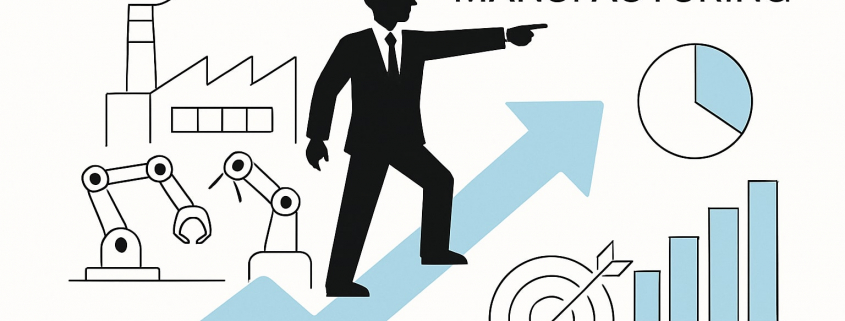

Leave a Reply
Want to join the discussion?Feel free to contribute!